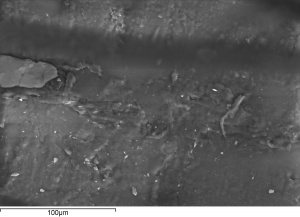Difference between revisions of "Salted paper"
m (→Description) |
|||
| Line 2: | Line 2: | ||
== Description == | == Description == | ||
| − | A type of photographic printing out paper. Developed by William Henry Fox Talbot, salted paper was prepared by directly soaking paper in a solution of [http://cameo.mfa.org/materials/fullrecord.asp?name=sodium%20chloride table salt ]then treating it with [http://cameo.mfa.org/materials/fullrecord.asp?name=silver%20nitrate silver nitrate]. By 1841, salted paper was made with a thin salt-filled gelatin coating that was dried then treated with silver nitrate to form a photosensitive silver halide compound. Gelatin was most commonly used as a binder, but other materials such as [ | + | A type of photographic printing out paper. Developed by William Henry Fox Talbot, salted paper was prepared by directly soaking paper in a solution of [http://cameo.mfa.org/materials/fullrecord.asp?name=sodium%20chloride table salt ]then treating it with [http://cameo.mfa.org/materials/fullrecord.asp?name=silver%20nitrate silver nitrate]. By 1841, salted paper was made with a thin salt-filled gelatin coating that was dried then treated with silver nitrate to form a photosensitive silver halide compound. Gelatin was most commonly used as a binder, but other materials such as [[albumen]], [[arrowroot starch]], [[agar-agar]], and [[starch]] were also used. The image was produced by exposing the paper to the sun through a negative then fixed with [http://cameo.mfa.org/materials/fullrecord.asp?name=potassium%20bromide potassium bromide] or [http://cameo.mfa.org/materials/fullrecord.asp?name=sodium%20thiosulfate sodium thiosulfate] solutions. By the 1860s, salted paper was replaced in popular use by [http://cameo.mfa.org/materials/fullrecord.asp?name=albumen%20paper albumen paper]. |
[[[SliderGallery rightalign|salt print sample 16 site2.jpg~SEM]]] | [[[SliderGallery rightalign|salt print sample 16 site2.jpg~SEM]]] | ||
Revision as of 07:55, 1 July 2014
Description
A type of photographic printing out paper. Developed by William Henry Fox Talbot, salted paper was prepared by directly soaking paper in a solution of table salt then treating it with silver nitrate. By 1841, salted paper was made with a thin salt-filled gelatin coating that was dried then treated with silver nitrate to form a photosensitive silver halide compound. Gelatin was most commonly used as a binder, but other materials such as Albumen, Arrowroot starch, Agar-agar, and Starch were also used. The image was produced by exposing the paper to the sun through a negative then fixed with potassium bromide or sodium thiosulfate solutions. By the 1860s, salted paper was replaced in popular use by albumen paper.
Synonyms and Related Terms
salted-paper; plain salted paper; papier salé (Fr.)
Additional Images
Authority
- Caring for your Collections, Arthur W Schulz (ed.), Harry N. Abrams, Inc. , New York, 1992 Comment: one of the earliest photographic printing process introduced in 1841
- James M. Reilly, Albumen & Salted Paper Book: The history and practice of photographic printing, 1840-1895, Light Impressions Corp., Rochester, NY, 1980 Comment: see chapter at http://albumen.stanford.edu/library/monographs/reilly/chap11.html
- E.J.LaBarre, Dictionary and Encyclopedia of Paper and Paper-making, Swets & Zeitlinger, Amsterdam, 1969
- Website address 1 Comment: Preservation 101 -glossary of terms at www.nedcc.org/p101cs/terms.htm - Invented by WHFT in 1841...popular until around 1860
- Website address 2 Comment: AMOL reCollections Glossary at http://amol.org.au/recollections/7/c/htm
- Luis Nadeau, Encyclopedia of Printing, Photographic, and Photomechanical Processes, Atelier, New Brunswick, 1997
- Thomas B. Brill, Light Its Interaction with Art and Antiquities, Plenum Press, New York City, 1980
- Art and Architecture Thesaurus Online, http://www.getty.edu/research/tools/vocabulary/aat/, J. Paul Getty Trust, Los Angeles, 2000








